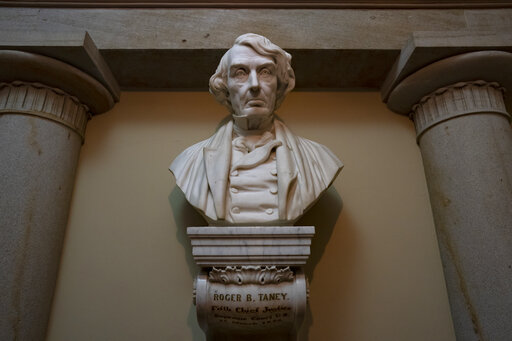WASHINGTON (AP) — The House will vote on whether to remove from the U.S. Capitol a bust of Chief Justice Roger B. Taney, the author of the 1857 Dred Scott decision that declared African Americans couldn’t be citizens.
The vote expected Wednesday will come as communities nationwide reexamine the people they’re memorializing with statues.
The 2-foot-high marble bust of Taney is outside a room in the Capitol where the Supreme Court met for half a century, from 1810 to 1860. It was in that room that Taney, the nation’s fifth chief justice, announced the Dred Scott decision, sometimes called the worst decision in the court’s history.
There’s at least one potentially surprising vote for Taney to stay. Lynne M. Jackson, Scott’s great-great-granddaughter, says if it were up to her, she’d leave Taney’s bust where it is. But she said she’d add something too: a bust of Dred Scott.
“I’m not really a fan of wiping things out,” Jackson said in a telephone interview with The Associated Press earlier this week from her home in Missouri.
The president and founder of The Dred Scott Heritage Foundation, Jackson has seen other Taney sculptures removed in recent years, particularly in Taney’s native Maryland, where he was the state’s attorney general before becoming U.S. attorney general and then chief justice.
In the summer of 2017, shortly after white nationalists gathered in Charlottesville, Virginia, to protest the removal of a statue of Confederate Gen. Robert E. Lee, Baltimore’s mayor removed statues of Lee, Taney and others. A statue of Taney was removed from the grounds of the State House in Annapolis, Maryland, around the same time. And a bust of Taney was removed that year from outside city hall in Frederick, Maryland.
But Taney’s name and likeness remain in plenty of other places. Missouri has a Taney County. Philadelphia has a Taney Street. And another Taney bust sits alongside all other former chief justices in the Supreme Court’s Great Hall, a soaring, marble-columned corridor that leads to the courtroom. A portrait of Taney hangs in one of the court’s conference rooms.
Jackson said she believes that what memorials honoring figures like Taney need is context. At the Capitol, the Taney statue sits in the “place where the Dred Scott case was decided,” but the fact he is “there by himself is lopsided,” Jackson said in suggesting a bust of Scott be added. She had proposed a similar fix for the Taney statue in Annapolis.
The bill lawmakers will vote on Wednesday proposes replacing the Taney bust with one of Justice Thurgood Marshall, who in 1967 became the Supreme Court’s first Black justice. A similar bill has been introduced in the Senate, but prospects for passage there are uncertain.
President Donald Trump has opposed the removal of historic statues elsewhere. And he’s strongly condemned those who toppled statues during protests over racial injustice and police brutality following the May death of George Floyd in Minneapolis.
In Congress, Taney’s bust was controversial from the start. When Illinois Sen. Lyman Trumbull proposed its creation in 1865, shortly after Taney’s death, he got into a heated debate with Massachusetts Sen. Charles Sumner, a fierce opponent of slavery.
“Let me tell that Senator that the name of Taney is to be hooted down the page of history. Judgment is beginning now,” Sumner said. “And an emancipated country will fasten upon him the stigma which he deserves.”
Funding for a Taney bust wasn’t approved until almost a decade later. Today, near the Taney bust, inside the old Supreme Court chamber, there are also busts of the nation’s first four chief justices. The first, John Marshall, is the only person to serve as chief justice longer than Taney and a revered figure in the law.
But Marshall too was a deeply flawed man, as were other justices, said Paul Finkelman, the president of Gratz College in Pennsylvania and the author of “Supreme Injustice: Slavery in the Nation’s Highest Court.” Marshall bought slaves most of his life, a fact his biographers largely ignored, and was hostile to the idea of Blacks gaining their freedom, Finkelman said. Before the Civil War, probably the majority of justices owned slaves, he said.
“It’s not pretty. It’s who they were,” Finkelman said.
